NA-50
Peruvian Air Force Fighter
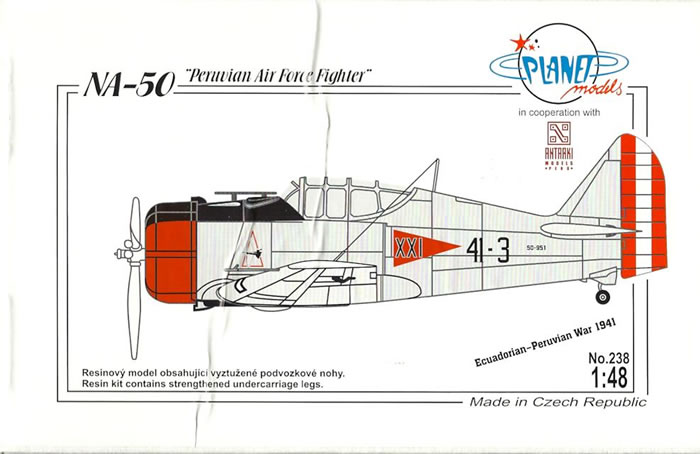
Planet Models / ANTARKI Models , 1/48 scale
S u m m a r y |
Catalogue Number: |
Planet Models / ANTARKI Models Kit No. 238 - NA-50 “Peruvian Air Force Fighter” |
Scale: |
1/48 |
Contents and Media: |
93 pieces in cream colored resin, reinforced resin gear legs in black and 2 clear vac-form canopies. Instructions, painting guide and decal sheet for 2 aircraft. |
Price: |
USD $61.99 from Sprue Brothers Models |
Review Type: |
First Look |
Advantages: |
Nicely engraved panel lines and good framing on the vac-form canopy. Single piece cowling with minimal pour stub attachment. |
Disadvantages: |
A bit of flash on many parts. Requires use of cyanoacrylic (super / crazy) glue and /or two-part epoxy. Some parts left up to the modeler to fashion. |
Conclusion: |
This kit is a great beginning for a new model company. |
Reviewed by Steven Eisenman

HyperScale is proudly supported by Squadron
It is quite common to read on any number of aircraft modeling web sites a list of aircraft that modelers would like to see produced. Some aircraft that appear on those lists are often a bit obscure or were produced in very small numbers. They are desired nonetheless.
Rarely, and I do mean once in a generation rarely, do we see modelers take the bull by the horns and transform their wishes into reality. Those modelers that come to mind are the likes of Bill Koster, of Koster Aero Enterprises, and Jules Bringuirer, of Bringuier Aviation Products and Classic Airframes. When it came to the unusual aircraft, it was Jules who stepped off the precipice and produced what he wanted, such as the Fokker G.1, Loire 46 and the Fokker D.XXI.
Now a new group of talented modelers has come forward to give life to their wish list. These modelers from Peru operate under the name of ANTARKI. Their wish list is based on the aircraft flown by the Cuerpo de Aeronáutica Peruana (CAP) [Peruvian Air Force], primarily during the early and mid-20th Century.
Contrary to what you are thinking, this is not the smallest wish list ever produced. The CAP flew a varied collection of aircraft from an array of nations: USA, Britain, France and Italy. Many of which were the latest models in production. In fact, Caproni had established production facilities in Peru. Early aircraft from the USA included the Northrop 8A-3P attack bomber and the North American NA-50 fighter-bomber.
It is with the NA-50 that ANTARKI has spread the fabric of its poncho to gather the wind so it can take flight. They are doing this through a collaborative effort with Planet Models / CMK. At the moment, the kit is listed under the Planet Models label, in cooperation with ANTARKI.
The North American NA-50 had its origins in the NA-16 trainer and the subsequent NA-26 with retractable landing gear. While the NA-16 eventually lead to the famous AT-6, it was also the basis for a number of fighter aircraft including the NA-50 and the NA-68 / P-64 and the NA-44 two seat ground attack aircraft.
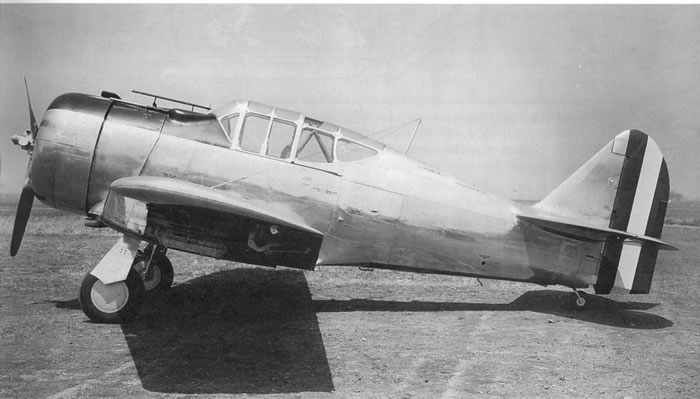
North American produced these aircraft with an eye to the lucrative export market, especially in Latin America, given the number of conflicts in the region during the 1930s.
Peru, on the other hand, having concluded a squabble with Columbia over a relatively inaccessible piece of territory, known as the Leticia Incident, began to expand its military and sought to expand its air power by purchasing aircraft from various sources. In 1939, Peru purchased seven NA-50s, nicknamed “Torito” (little bull). The NA-50s were equipped with two .30 cal. machine guns in the cowling; the CAP added bomb racks under the wings.
The NA-50 first saw combat with the CAP in the summer of 1941 when Peru decided to resolve a territorial dispute with Ecuador. Although two “Toritos” were lost, one to an accidental explosion and the other to ground fire, the dispute was quickly resolved in favor of the much stronger Peru. The remaining NA-50s serviced on with the CAP into the 1950’s as trainers.
The Kit
ANTARKI’s first effort is quite nice indeed. As I find with most kits from Planet Models, there are no air bubbles or pits in the resin. There is some flash, but it is very thin and easily removed with the tip of a #11 blade.
There are no large pour plugs with massive attachment points to contend with. The pour plug on the cowling is attached at a number of small points, rather than a continuous join. One can quickly cut through the joins with a razor saw, then sand down the remaining excess resin.
A quick holding together of the parts seems to show no fit issues. In fact, this appears to be a nice starting point for anyone who has not done, but would like to do, a resin kit. I believe that this would be a nice one-day Saturday or Sunday project. Or for those who live in the North East USA, a snow day project.
For those who have not built resin kits, one must use cyanoacrylic (“CA” / Super Glue). Since there are no aligning tabs and most of the joins are butt joins, I find a slow setting gel to be easier to use. It allows for a short period to get everything aligned. It also allows for filling in gaps in parts that may not be a tight fit; not uncommon in a resin kit. I recently found the Gorilla Glue “Super Glue” to be excellent. It is not as thick as most slow set gels, allows time to move a part and the tip on the tube version does not clog.
Probably the most difficult part of the kit is setting the engine in the cowling, as this is usually the only way the engine can be attached. One may find that the individual cylinders are too large in diameter and the engine will not fit in the cowl. Some cutting of the base of the cylinder may be required. A little bit of plastic card shim can always be glued inside the cowl, should the fit be loose.
The level of detail is nice, although basic. The engraved panel lines are quite fine and not very deep, as they should be for this aircraft. No old-fashioned resin trenches on this kit. The tubular framework in the cockpit is molded on the inside of the fuselage halves. There is a separate part for the tubular cockpit floor. There is no etched metal in the kits, so you will need to make a seat belt for the nicely molded seat.
As for the color of the interior, there is nothing in the instructions to indicate what color to paint the interior. It is my understanding that the interior was a “green”, not much more than that. One could “guesstimate”, based on what North American did with other aircraft, that the sidewalls and framework were an early interior green and that the seat may have been dull dark green.
The gear legs are “reinforced resin”; they are molded with a wire inside. But, they are still resin, so use care in cutting them off the block. Having built a number of resin kits, I have not had any gear melt or break sitting on a shelf. But, it cannot hurt.
There are two very thin and clear vac-form canopies. The canopy frames are quite distinct, so seeing where to cut them out and masking will be reasonably easy.
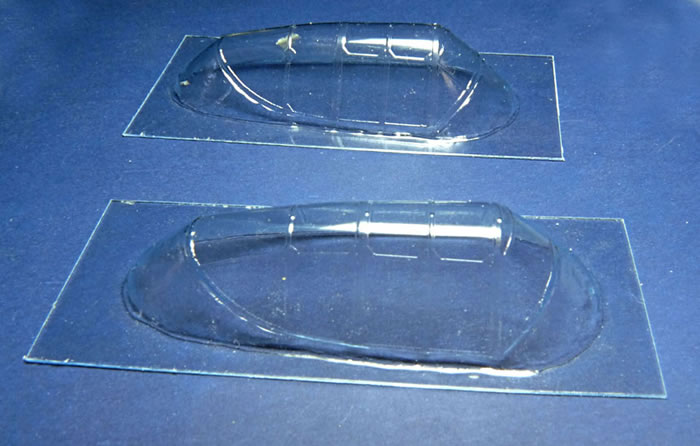
You will, however, have to supply or scratch build some parts for the kit, two machine gun barrels and a sighting tube. The machine guns are simply .30 cal Browning, so hopefully there are some in your parts bin. As for the sighting tube, this can be made from a piece of starched sprue or an approximately 20 thou diameter piece of rod stock.
Markings:
There are sufficient markings for two aircraft, both of which are in overall aluminum.
The first aircraft is for the aircraft of Lt. CAP Antonio Alberti (Squadron Leader); 41 Escuadrilla del XXI Escuadrón de Caza; July 1941. This aircraft, 41-1, has the front of the cowl painted blue and the rear of the cowl in white with a black anti-glare panel. It also has the Leader’s fuselage chevron. There appears to be some debate as to whether it was the red of the Peruvian roundel or black. The instructions favor the red. As for me...
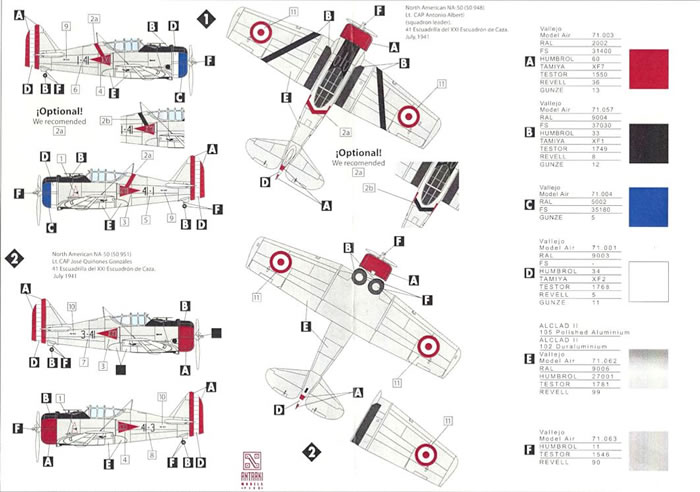
The second aircraft is for Lt. CAP José Quiñones Gonzáles; 41 Escuadrilla del XXI Escuadrón de Caza; July 1941. This aircraft, 41-3, has the entire cowling in the red of the Peruvian roundel with a black anti-glare panel.
A note of caution: The top view on the painting guide shows an aircraft with the Leader’s chevron, but the red cowling of Gonzáles’s aircraft. The chevron belongs on 41-1, not 41-3.
The decals were designed in Peru and printed under the Planet Models logo. They are in good register with nice depth of color.
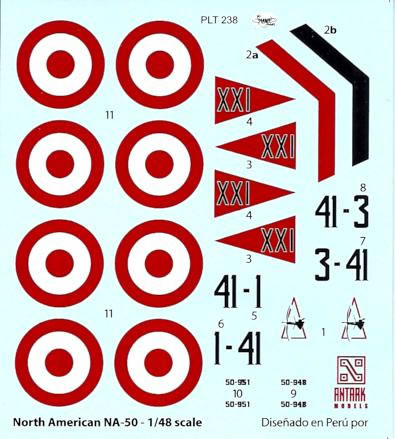
However, you will need to do some painting to complete the markings. The first is the rudder stripes of red – white –red. This means you will need to attempt to match the red of the roundel. The second items are the diagonal wing-top bands in black. Finally, the black wing walks.
I believe this kit is a great beginning for a new and emerging model company, ANTARKI Models of Peru. Hopefully ANTARKI will catch the wind and take flight with this kit. While not on the cutting edge of resin kits, I believe this model of the NA- 50 will build into a very nice representation of the aircraft. Considering how few NA-50s were actually built, this is a unique model of unique aircraft.
As for ANTARKI’s future, I understand there are a number of projects on the table. The next project is already in production, the Caproni Ca 113 bi-plane. This can be seen at the CMK web site:
http://www.cmkkits.com/en/aircraft/caproni-ca-113/
One final word and warning. Some of the early production kits are missing a part #30. There should be two, but the early kits only had one. Of course mine is one of them. Should you be missing a part #30, please contact Planet Models / CMK: http://www.cmkkits.com/en/page/contact-us/
References:
North American NA-50 ‘Les Petits Taureaux Du CAP’ by Amaru Tincopa.
Latin American Air Wars and Aircraft 1912 – 1969 by Dan Hagedorn; Hikoki Publications; 2006.
Thanks to ANTARKI Models for the review sample
Review Text and Images Copyright © 2010 by Steven Eisenman
Page Created 15 February, 2011
Last updated
15 February, 2011
Back to HyperScale Main Page

|
